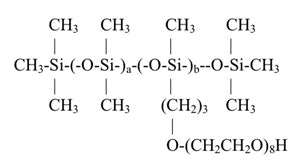Industry expert Tony O'Lenick explains: What is the difference between bis-PEG-8 and PEG-8 dimethicone?
The nomenclature related to what used to be called dimethicone copolyol has undergone a number of rule changes since 1999. Prior to 1999, all silicone compounds containing polyoxyethylene (PEG) or polyoxypropylene (PPG) groups, regardless of number, were referred to as dimethicone copolyol.
The rules have since changed. Under the first change, the number of moles of PEG and PPG were listed in the name. This results in the well-known PEG-8 dimethicone name.
The newer rules also differentiate between terminal and comb materials.

FIgure 1. Original name: Dimethicone copolyol intermediate; Name: PEG-8 dimethicone; New name: PEG-8 dimethicone

Figure 2. Original name: Dimethicone copolyol intermediate; Name: PEG-8 dimethicone; New name: bis-PEG-8 dimethicone
While the new name does provide more information, it cannot be used for determination of critical information like water solubility since the values of “a”, “b” and “c” (see Figure 1) are not disclosed, and these taken together with the number of moles of PEG or PPG allow for the determination of such properties.










